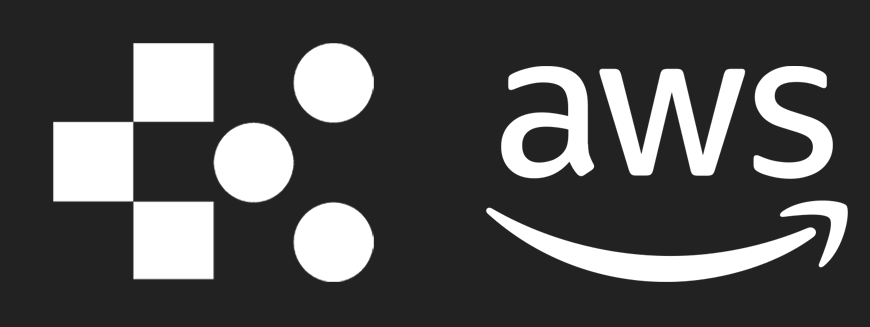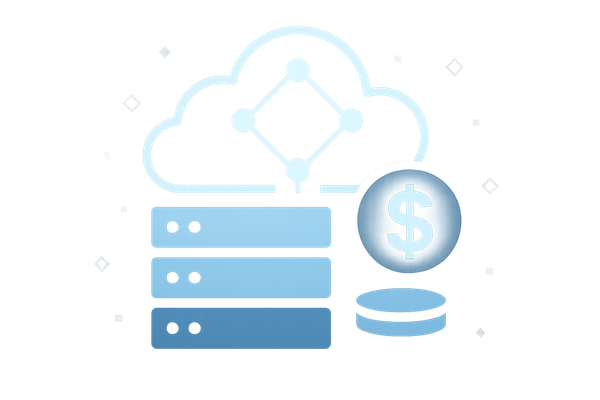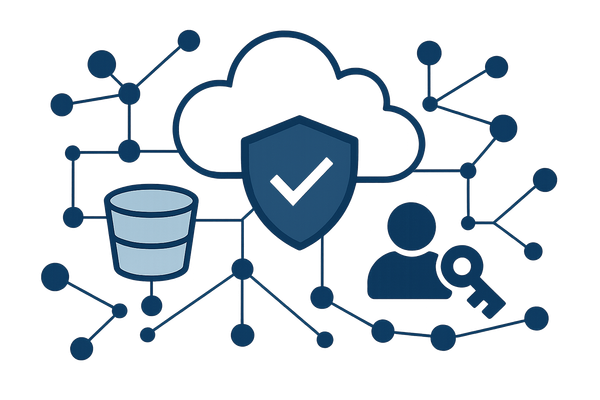AWS Cross-Region Data Transfer Costs: 7 Ways To Reduce
Explore seven effective strategies to reduce AWS cross-region data transfer costs and optimise your cloud spending without sacrificing performance.
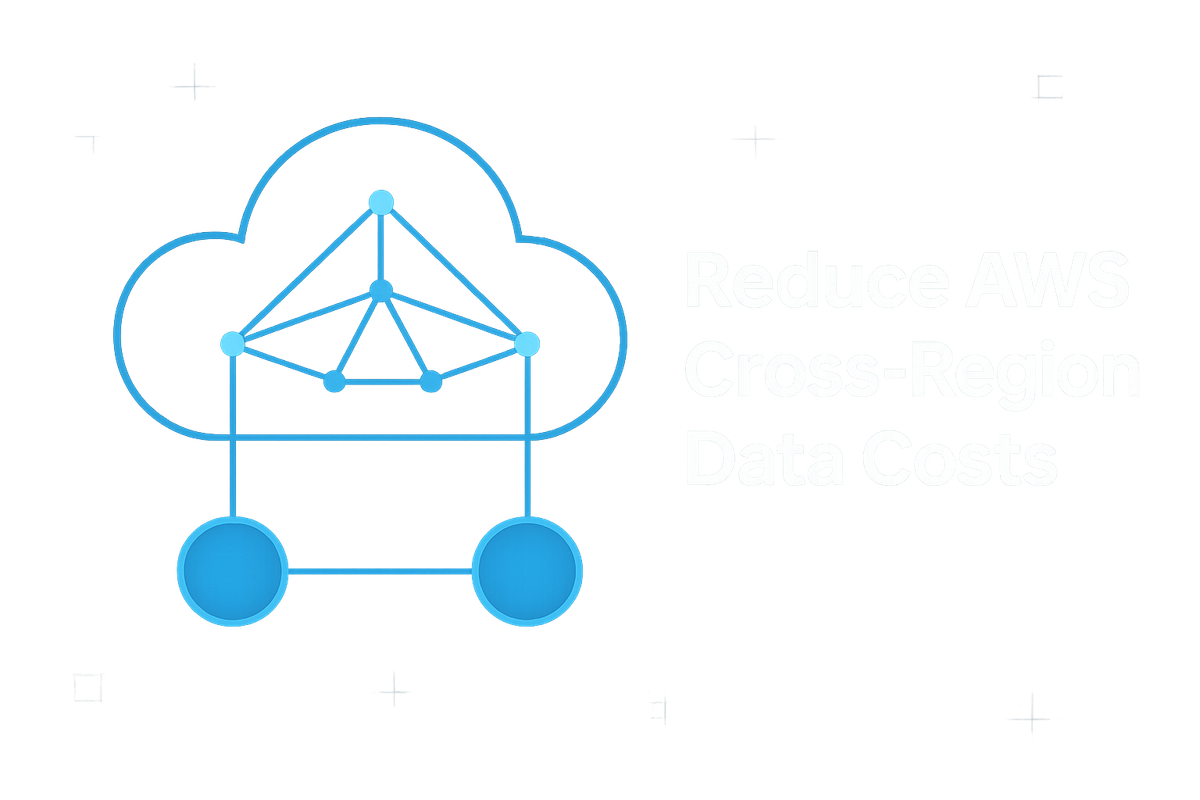
AWS cross-region data transfers can quickly inflate your cloud bill. For UK small and medium-sized businesses (SMBs), these costs often stem from moving data between regions for backups, disaster recovery, or global applications. At £0.07 per GB, transferring 1TB monthly could cost £840 annually. But you don’t have to overspend.
Here are 7 strategies to lower these costs:
- Track and Analyse Data Transfers: Use AWS tools like Cost Explorer and CloudWatch to monitor usage and identify expensive transfers.
- Combine Workloads in Fewer Regions: Group related services in the same region to cut unnecessary inter-region communication.
- Use CloudFront and Caching: Cache data closer to users to reduce cross-region traffic.
- Set Up S3 Multi-Region Access Points: Automatically route users to the nearest S3 bucket, reducing transfer costs.
- Improve Data Replication: Use delta replication or AWS DataSync to transfer only updated data.
- Pick Budget-Friendly Regions: Host workloads in regions with lower transfer costs, such as US East (N. Virginia).
- Add Data Compression: Compress files before transfer to reduce data size and costs.
Each method offers varying levels of savings and complexity. Start small with monitoring and compression, then explore architectural changes like consolidation or caching for bigger reductions. With these steps, you can cut AWS cross-region transfer costs by 20–40%.
AWS Data Transfer Costs for Common Architectures | Pricing across AWS Regions and Availability Zones
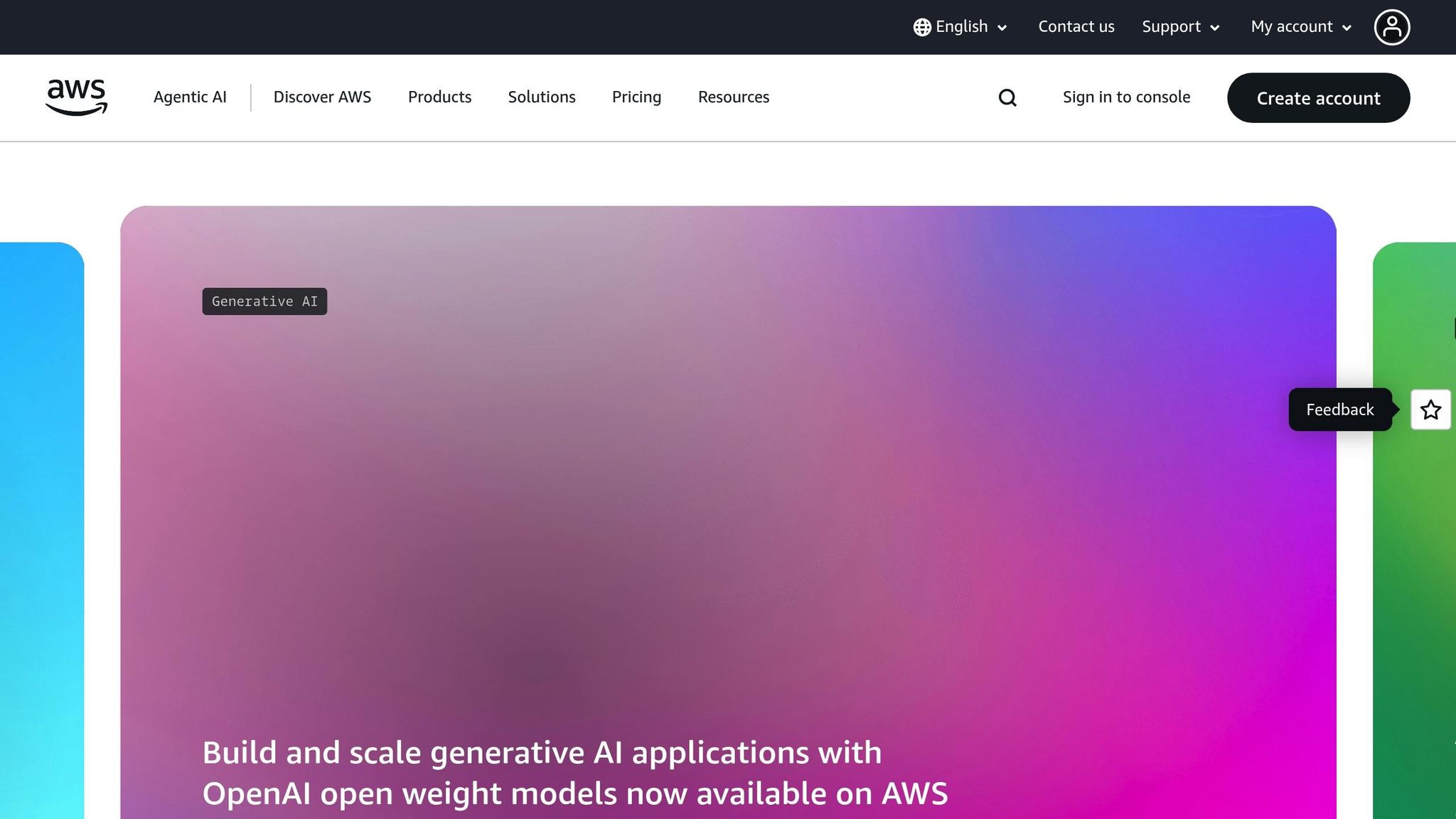
How AWS Cross-Region Data Transfer Costs Work
Cross-region data transfer on AWS happens when data is moved between different AWS regions. For example, transferring data from London (Europe) to Frankfurt (Europe) or from London to US East (N. Virginia). Unlike data transfers within the same region, cross-region transfers typically come with higher costs. Let’s take a closer look at what influences these charges.
Inbound data transfers to AWS are always free, no matter the region. However, outbound transfers - whether to another AWS region or the internet - are charged based on the originating region and the service involved. Similarly, when data moves between regions via VPC peering, Transit Gateway, or direct service interactions, charges are applied depending on the source and destination regions.
"Traffic that crosses a Regional boundary will typically incur a data transfer charge. Avoid cross-Region data transfer unless your business case requires it." – AWS Architecture Blog
Why might you need cross-region transfers? Common use cases include disaster recovery, where critical data is replicated from London to another European region to ensure business continuity, or global applications that store data closer to users for better performance. Additionally, some businesses must follow legal data residency rules, which may require storing data in specific regions.
The cost of cross-region transfers depends on several factors: the services involved, how much data is being transferred, and the distance between regions. For instance, transferring data between European regions is generally less expensive than moving it to Asia-Pacific or the Americas. This difference reflects the varying costs of infrastructure and the complexity of network routing between regions .
1. Track and Analyse Data Transfer with AWS Tools
To cut costs effectively, you need to start by measuring and analysing. AWS offers several built-in tools to help you monitor and understand cross-region data transfers. These tools provide the insight needed to pinpoint areas where you can save.
AWS Cost Explorer is your go-to tool for tracking data transfer expenses. It breaks down your monthly bill by service and region, helping you identify the most expensive transfers. You can filter for data transfer costs and review historical data to spot trends and patterns.
CloudWatch enables real-time tracking of your data transfer metrics. With custom dashboards, you can monitor bandwidth usage across services like EC2, S3, and RDS. Metrics like NetworkIn and NetworkOut help you understand how much data is moving between regions and highlight any unusual spikes in activity.
AWS Cost and Usage Reports provide detailed billing data that can be exported for further analysis. These reports include specific line items for cross-region transfers, complete with timestamps and service details. This makes it easier to trace costs back to specific applications or workloads.
VPC Flow Logs capture IP traffic to and from your VPC interfaces. When enabled across multiple regions, these logs reveal which applications are generating the most cross-region traffic. This can help you evaluate whether the traffic is necessary or if adjustments can be made to reduce costs.
Cost Impact
Monitoring tools like these help you identify unnecessary data transfers, ultimately aiding in cost control. Many of AWS’s built-in tools are either free or come with minimal charges, making them a budget-friendly way to manage expenses.
Implementation Complexity
For most small and medium-sized businesses, setting up these tools is relatively simple. AWS Cost Explorer is ready to use directly from the AWS console. CloudWatch dashboards require only minimal setup, and enabling VPC Flow Logs across regions is a straightforward process.
Best Use Cases
This approach is especially useful for businesses dealing with unexpected billing spikes or those running multiple applications across regions. Companies with seasonal traffic can also benefit by analysing historical trends to better plan for peak periods.
Potential Trade-offs
While some AWS services may charge for detailed monitoring, the insights gained often outweigh the costs. If the sheer volume of data feels overwhelming, start with high-level overviews in AWS Cost Explorer. Once you’re comfortable, you can dive deeper into more detailed metrics to refine your cost-saving strategies. From here, you can also look into consolidating workloads across regions to further cut expenses.
2. Combine Workloads in Fewer Regions
Reducing cross-region data transfer costs is one of the easiest ways to optimise your AWS spending, and consolidating workloads into fewer regions is a smart way to achieve this. When your applications, databases, and services are scattered across multiple AWS regions, they generate extra data transfer fees as they communicate with each other. By grouping related workloads in the same region, you can significantly cut down on these charges.
Start by assessing which services genuinely need to be in separate regions and which are spread out simply due to convenience or lack of planning. For instance, you might find a database running in one region while its corresponding application servers are in another - perhaps because different teams deployed resources in their preferred locations. Moving tightly connected components into the same region can eliminate unnecessary inter-region communication costs.
When consolidating, take into account both your technical requirements and the geographic spread of your users. If most of your customers are based in Europe, for example, consolidating workloads in European regions like eu-west-1 or eu-central-1 can not only reduce costs but also improve performance by minimising latency. This approach delivers a dual benefit: lower expenses and better user experience.
Cost Impact
Cutting out inter-region data transfers can lead to noticeable savings, especially for data-heavy applications. As your data usage grows, those seemingly small per-unit transfer fees can quickly add up, making it essential to reduce unnecessary transfers. This strategy is particularly impactful for companies with large-scale data operations.
Implementation Complexity
How challenging it is to consolidate workloads depends on your current setup. Straightforward changes, such as moving a database to the same region as its application, can often be done during regular maintenance with minimal disruption. However, more complex architectures - those with hard-coded region dependencies, custom DNS settings, or strict compliance requirements - may need a phased migration approach. AWS provides migration tools to ease the process, though some manual adjustments might still be required.
Best Use Cases
Consolidation is especially effective in scenarios where geographic distribution isn’t a priority. For example:
- Development and testing environments: These often don’t need to be spread across multiple regions and can rack up unnecessary transfer costs.
- Tightly integrated systems: Workloads that require frequent data synchronisation can benefit greatly from being in the same region.
- Startups and growing businesses: Consolidating into one or two strategic regions helps smaller organisations manage costs more efficiently as they scale.
Potential Trade-offs
While consolidating workloads offers clear cost savings, there are trade-offs to consider. Reducing the number of regions can impact disaster recovery and high availability, as geographic redundancy is diminished. To address this, you can leverage multiple Availability Zones within the chosen region and implement strong backup strategies. Another potential downside is increased latency for users located farther from the consolidated region. Lastly, ensure compliance with industry regulations, as some require data to remain in specific regions.
3. Use Amazon CloudFront and Caching Solutions
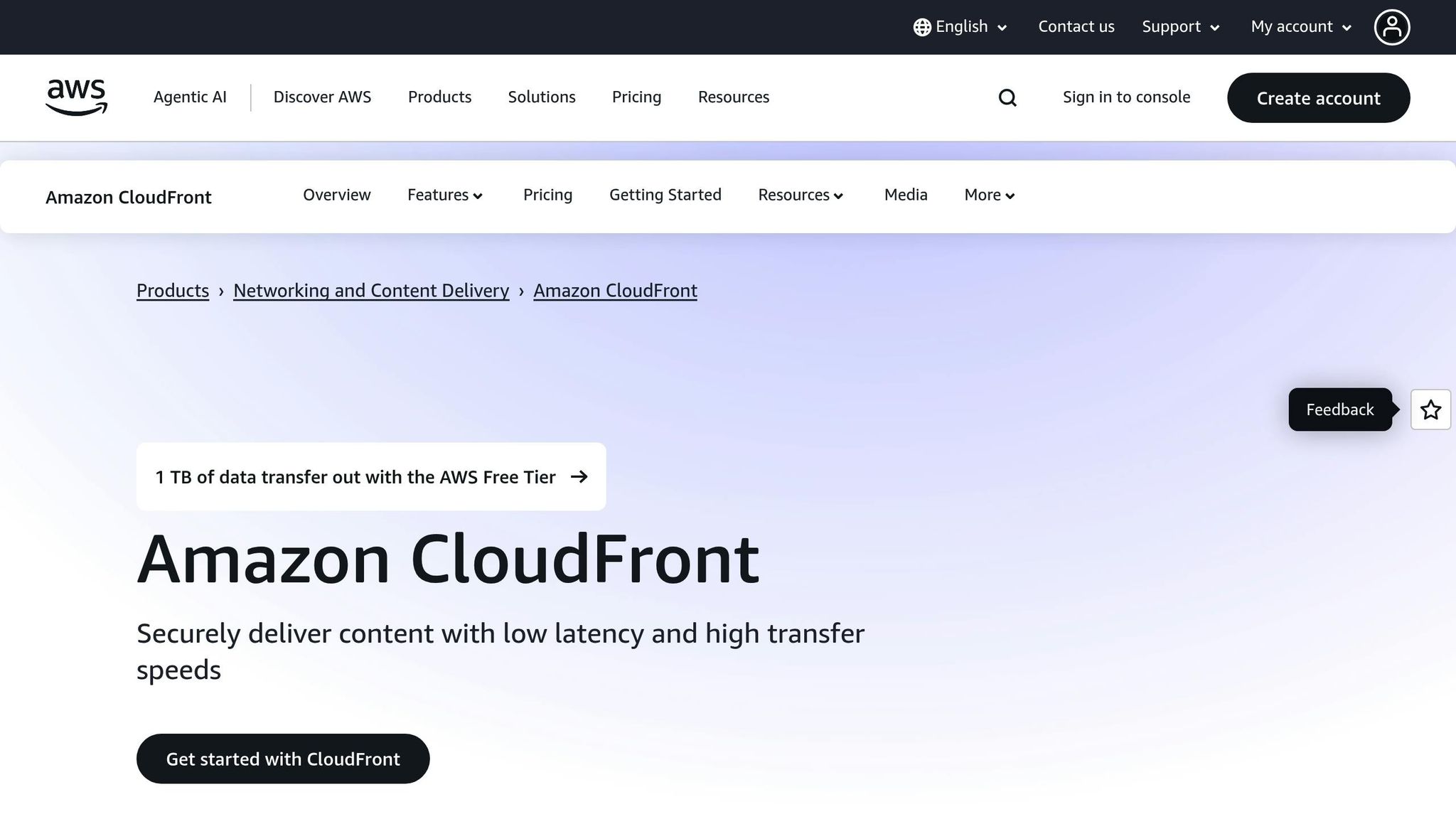
Amazon CloudFront serves as a powerful tool for improving performance and cutting costs by acting as a bridge between users and AWS infrastructure. It works by caching data at edge locations around the globe, bringing content closer to users and reducing the strain on origin servers.
Here’s an example: Suppose an application hosted in eu-west-1 needs to deliver content to a user in Singapore. Instead of incurring cross-region transfer costs by serving the content directly, CloudFront can fetch and deliver the data from an edge location in Asia. This not only reduces cross-region transfer expenses but also significantly improves response times.
When paired with caching solutions like ElastiCache, CloudFront takes efficiency to the next level. ElastiCache stores frequently accessed data locally, cutting down on repetitive database queries across regions. Similarly, application-level caching can minimise unnecessary API calls, further optimising data delivery.
Cost Impact
By reducing the frequency of cross-region data transfers, CloudFront and caching solutions help lower operational costs, especially for applications that handle large volumes of content. They also reduce the load on origin servers, leading to better performance and cost efficiency.
Implementation Complexity
Setting up a basic CloudFront distribution is straightforward and can be done in minutes through the AWS Console. However, complexities arise when custom configurations are needed, such as setting up SSL certificates, defining caching behaviours, or integrating with other AWS services.
ElastiCache, on the other hand, requires more planning. Applications need to be adapted to query the cache before accessing remote databases. This also involves implementing cache invalidation strategies to manage stale data and handling cache misses. Fortunately, AWS provides extensive documentation and SDKs to simplify the process.
Best Use Cases
CloudFront shines when delivering static assets like images, media files, or API responses that don’t change often. It’s ideal for websites showcasing product catalogues, SaaS applications serving dashboard data, or platforms streaming video content.
ElastiCache is particularly beneficial for systems with predictable data access patterns. Examples include customer relationship management tools, inventory systems, or any application with recurring data requests that can benefit from reduced cross-region database interactions.
Potential Trade-offs
While caching offers efficiency and cost savings, it can introduce challenges with data consistency and freshness. This is particularly critical for dynamic content, such as pricing or inventory levels, where outdated information could lead to user dissatisfaction. Effective cache invalidation strategies are essential to mitigate this risk.
Adding CloudFront to your architecture also introduces complexity in monitoring and troubleshooting. For instance, cache warm-up times could cause slight delays initially, and diagnosing issues may require monitoring both CloudFront and your primary infrastructure.
For more tailored AWS optimisation strategies for small and medium-sized businesses, check out AWS Optimization Tips, Costs & Best Practices for Small and Medium sized businesses.
4. Set Up S3 Multi-Region Access Points and Smart Routing
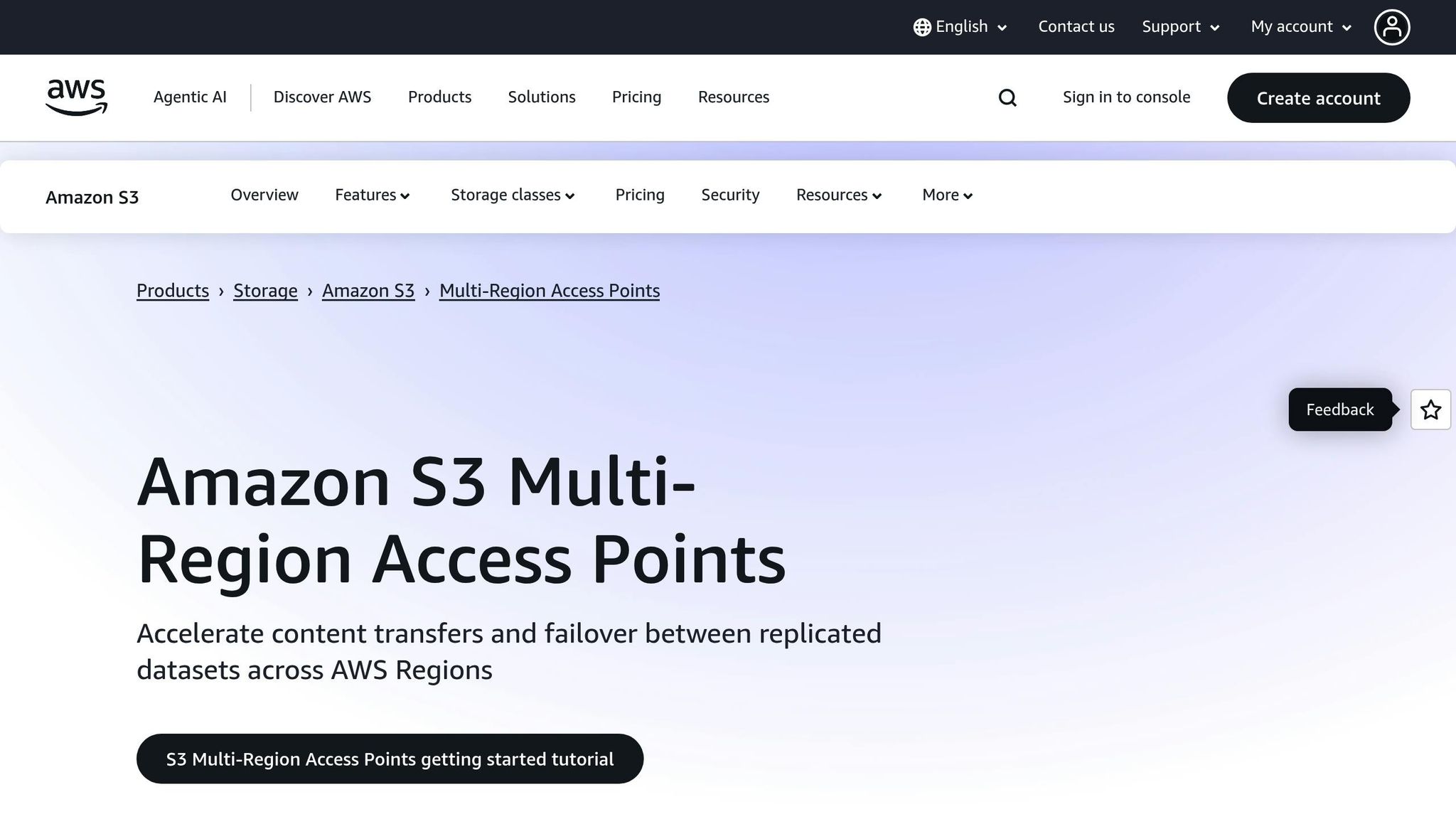
If you're looking to cut down on data transfer costs while improving efficiency, S3 Multi-Region Access Points can be a game-changer. This feature simplifies data access across multiple AWS regions, making it easier to manage and optimise your cloud resources.
S3 Multi-Region Access Points provide a single global endpoint that automatically routes requests to the closest S3 bucket. This eliminates the need to manually manage multiple endpoints and reduces cross-region data transfer costs by directing users to the nearest available data source.
How It Works
The system creates a unified access point that spans multiple AWS regions. When a user requests data, it evaluates factors like network latency, bucket availability, and routing policies to determine the best route. For instance, if your application serves users in Europe and Asia, European users can be directed to eu-west-1 buckets, while Asian traffic is routed to ap-southeast-1 buckets - all through one endpoint.
What makes this even more powerful is its ability to adapt in real time. Smart routing reacts to network conditions and automatically fails over when necessary, ensuring consistent performance and reliability without the need for manual intervention.
Cost Savings
One of the biggest benefits of Multi-Region Access Points is their ability to reduce cross-region transfer costs. Instead of funnelling all traffic to a single region (and paying higher transfer fees), requests are routed to the most cost-effective location. For businesses with global users, this can lead to noticeable cost reductions.
Beyond savings on transfer fees, this setup can also improve performance and reduce compute costs. By localising traffic, servers handle requests more efficiently, which can translate into smoother operations and lower expenses.
Implementation Considerations
While the setup process isn’t overly complex, it does require some technical planning. You’ll need to:
- Create buckets in the target regions.
- Configure replication between the buckets.
- Set up the Multi-Region Access Point via the AWS Console or CLI.
The main challenge lies in maintaining data consistency across regions. Since replication isn’t instantaneous, there’s a chance that recently uploaded data won’t immediately appear in all regions. To address this, you’ll need to implement retry logic and account for replication delays, which usually range from a few seconds to a few minutes depending on the data size and network conditions.
Monitoring also becomes more involved. You’ll need to oversee multiple regions and keep an eye on replication status. AWS CloudWatch can help by providing metrics to flag replication failures or unusual traffic patterns. Balancing these complexities with the potential savings is key to a successful multi-region strategy.
Ideal Scenarios
Multi-Region Access Points shine in scenarios where users are spread across different regions and the content they access doesn’t change frequently. Examples include:
- Content management systems, media libraries, and document repositories: These often serve static or semi-static content to global audiences.
- E-commerce platforms: Storing product images and marketing assets closer to users can improve load times and reduce costs.
- Backup and archival systems: Data that rarely changes but needs to be accessible from multiple regions is a great fit.
- Software distribution: Teams distributing software packages or container images across regions benefit from a single endpoint that simplifies deployment and reduces transfer fees.
Challenges to Keep in Mind
While Multi-Region Access Points offer plenty of advantages, they come with some trade-offs:
- Data consistency: If your application requires immediate consistency, you may run into issues when users are routed to regions where replication hasn’t completed. This requires careful design to manage user expectations and minimise disruptions.
- Replication costs: While cross-region transfer costs decrease, you’ll still incur S3 Cross-Region Replication charges. If your data changes frequently, these costs could offset some of the savings.
- Troubleshooting complexity: Multi-region setups can make debugging more challenging. Problems might arise from network issues, replication delays, or regional service disruptions, requiring more advanced monitoring and troubleshooting tools.
5. Improve Data Replication Methods
Efficient data replication is key to maintaining availability and ensuring robust disaster recovery, all while keeping cross-region transfer costs manageable. Traditional replication methods often involve duplicating entire datasets between regions, even when only a small portion of the data has been updated. This approach can lead to excessive data transfer volumes and unnecessary expenses.
A smarter approach is delta replication, which transfers only the data that has changed since the last synchronisation. For example, instead of replicating an entire database, only the modified segments are updated. This technique significantly reduces the amount of data transferred, helping to cut down on AWS cross-region transfer costs.
Tools like AWS DataSync simplify delta replication by automatically detecting changes and transferring only the updates. It also handles compression and encryption during transit to enhance security and efficiency. Similarly, AWS Database Migration Service (DMS) uses change data capture to replicate only modified records in your databases, streamlining the process further.
Another cost-saving tactic is strategic scheduling of replication jobs. Instead of continuous replication, businesses can batch transfers during periods of optimal network performance, improving transfer speeds and minimising retries. These strategies collectively help reduce costs while maintaining effective replication.
Cost Impact
Delta replication, combined with compression, reduces data transfer volumes and costs while improving overall efficiency.
Implementation Complexity
While these advanced methods offer clear benefits, they do come with some technical challenges. AWS DataSync is relatively straightforward to configure via the AWS Management Console, but setting up DMS for databases may require more upfront effort. Over time, however, these tools automate much of the process, making ongoing management easier.
One challenge is managing replication conflicts, particularly when multiple regions are updated simultaneously. Solutions like timestamp-based conflict resolution or designating a primary region for write operations can help maintain data consistency. Additionally, monitoring tools like AWS CloudWatch can track important metrics, such as replication lag and data change volumes, to ensure your replication processes run smoothly.
Best Use Cases
Delta replication works particularly well in environments where only specific data segments are frequently updated. Examples include content management systems and development or testing environments. Industries with strict compliance needs, such as healthcare and financial services, can also benefit by replicating only the most recent changes required for regulatory purposes.
Potential Trade-offs
While delta replication offers clear cost savings, it does introduce some complexities. Troubleshooting failures can be more intricate, as issues may only affect specific data segments, requiring targeted recovery efforts. Additionally, maintaining metadata for tracking changes can slightly increase storage requirements.
Teams may also face a learning curve when implementing change tracking, compression, and conflict resolution processes. During the initial synchronisation phase, when the system establishes a baseline for tracking changes, there may be a temporary increase in latency. However, this typically stabilises once the initial replication cycle is complete.
6. Pick Budget-Friendly Regions and Services
Choosing cost-effective AWS regions can significantly reduce cross-region transfer fees, helping you manage costs more effectively. This strategy builds on earlier methods by focusing on the price differences between AWS regions.
AWS region pricing isn’t uniform across the globe. According to nOps:
"AWS regions within the United States and Canada are the cheapest. On the other hand, Singapore, India, and South American countries tend to be costlier."
For example, placing workloads in regions like US East (Northern Virginia) can cut transfer costs. Data transfer out of the N. Virginia region costs between £0.05 and £0.09 per GB, depending on the volume tier. Transfers between US regions, such as Ohio and Northern Virginia, are even cheaper at just £0.01 per GB.
AWS only charges for outbound data transfers from the source region, so selecting a source region wisely is key. Tools like the AWS Pricing Calculator can help you estimate transfer costs based on different regional setups. Additionally, reviewing AWS Cost and Usage Reports (CUR) via the lineItem/UsageType column can reveal where costly regional transfers are occurring.
Cost Impact
Opting for budget-friendly regions can make a noticeable difference in your cross-region transfer expenses, especially for applications with high data volumes.
Implementation Complexity
Switching to a new region isn’t without challenges. You’ll need to consider factors like latency and compliance. While US and Canadian regions often offer lower pricing, they may not suit applications that need to serve users in other parts of the world or comply with specific data residency laws.
The complexity of migration depends on your existing architecture. Moving static content or databases to more affordable regions is relatively simple. However, applications with real-time user interactions may require a more careful balance between cost savings and performance.
Best Use Cases
This approach works well for specific scenarios:
- Backup and disaster recovery: These workloads can tolerate higher latency, making cost-effective regions a good fit.
- Development and testing environments: These typically don’t require the geographical distribution needed for production systems.
- Content distribution and data archiving: Pairing budget-friendly regions with services like CloudFront can optimise costs for global content delivery.
Potential Trade-offs
There are some trade-offs to consider. Hosting in lower-cost regions like North America may lead to higher latency for users located in Europe or Asia. Additionally, compliance requirements could limit your choice of regions, particularly in industries like financial services or healthcare that have strict data residency rules. Lastly, some AWS services may not be available in all regions, which could restrict your architectural options when prioritising cost over features.
7. Add Data Compression and Better Transfer Methods
Reducing the size of your data transfers can significantly lower costs, and one effective way to do this is through data compression and optimised transfer protocols. These methods work hand-in-hand with other strategies to minimise transfer volumes and improve efficiency.
For text-based data like logs, JSON files, or database exports, applying Gzip compression is a smart move. It shrinks file sizes, making transfers quicker and less costly. If you're transferring files to S3, compress them beforehand to boost efficiency.
In cases where speed is a priority, transfer acceleration techniques can make a difference. Tools like AWS DataSync are particularly handy, as they only transfer the parts of a file that have changed. Additionally, tweaking your database replication settings to enable built-in compression can further streamline your data management.
Cost Impact
Using compression and transfer optimisation can lead to noticeable savings, especially for data-heavy workloads. The exact financial impact will vary depending on the type and size of your data, as well as the frequency of transfers.
Implementation Complexity
Adding compression to your workflows is often a straightforward process. Many AWS services already include options for data compression, so you might only need to make minor adjustments to your configurations. However, keep in mind that compressing and decompressing data uses CPU resources. Fortunately, modern AWS instances are well-equipped to handle this load. For applications with high throughput, you may need to scale up your instance sizes to balance the additional processing demands.
Best Use Cases
Compression is particularly effective in scenarios like:
- Log aggregation systems
- Database backups
- Development environments
- Content management systems with large codebases or configuration files
These use cases often involve repetitive or text-heavy data, which compresses efficiently, leading to substantial cost reductions.
Potential Trade-offs
While compression reduces file sizes and speeds up transfers, it does come with some trade-offs. The compression and decompression process requires extra CPU time, which can add latency. This might be problematic for real-time applications where immediate data access is critical. Additionally, certain file types, like JPEG images or MP4 videos, are already compressed and won't benefit much from further compression.
Cost Reduction Methods Compared
When it comes to trimming costs, the right strategy depends on your workload patterns, technical expertise, and budget. Each method has its own advantages and challenges, so it’s essential to choose the one that aligns best with your business priorities.
| Strategy | Cost Impact | Implementation Complexity | Best For |
|---|---|---|---|
| Track and Analyse Data Transfer | Low–Medium | Low | Businesses looking for better visibility into transfer costs |
| Combine Workloads in Fewer Regions | High | Medium–High | Applications that can handle minor latency increases |
| Use CloudFront and Caching | Medium–High | Low–Medium | Content-heavy websites and applications |
| S3 Multi-Region Access Points | Medium | Medium | Apps with global users and heavy S3 usage |
| Improve Data Replication Methods | Medium–High | High | Database-driven apps with cross-region replication needs |
| Pick Budget-Friendly Regions | Medium | Low–Medium | New deployments or apps with flexible location requirements |
| Data Compression and Transfer Methods | Medium | Low–Medium | Text-heavy data scenarios like logs or backups |
These options illustrate the balance between cost impact and the effort required for implementation. For businesses just starting with cost optimisation, tools for monitoring and data compression can deliver quick, low-disruption wins. Over time, you can phase in more complex architectural adjustments, such as consolidating workloads or adding caching solutions.
Regional pricing is another key factor to consider. Comparing costs across regions can help you make smarter decisions about where to host your workloads.
| Region | Data Transfer Out (per GB) | Typical Use Case | Cost Advantage |
|---|---|---|---|
| Europe (London) | Approximately £0.09 | UK-based apps and compliance needs | Lowest latency for UK users |
| Europe (Ireland) | Approximately £0.09 | European HQs needing GDPR compliance | Wide service availability |
| Europe (Frankfurt) | Approximately £0.09 | Central European users and German markets | Strong connectivity for DACH countries |
| Europe (Paris) | Approximately £0.09 | French-specific markets and data residency | Meets local data sovereignty rules |
A layered approach often works best. For example, a small or medium-sized business (SMB) might start by monitoring data transfer patterns and applying compression techniques. From there, they could consolidate workloads and add caching tools for further savings. This step-by-step method minimises disruption while setting the stage for long-term cost benefits.
By pairing the right region with these strategies, UK SMBs can significantly lower their AWS expenses. Use the tables above to weigh the impact and feasibility of each approach based on your specific needs.
For more tips and strategies tailored to UK SMBs, check out AWS Optimization Tips, Costs & Best Practices for Small and Medium Sized Businesses.
Conclusion
Effectively managing AWS cross-region data transfer costs is achievable with the right approach. As outlined earlier, each strategy contributes to reducing expenses while maintaining both performance and reliability.
Start with straightforward steps like monitoring usage and compressing data. These are easy to implement and create immediate savings. Once those are in place, you can explore more complex architectural changes to unlock further cost reductions. This gradual approach minimises disruptions and allows your team to develop the necessary skills over time. For those ready to take it up a notch, advanced options like S3 Multi-Region Access Points and optimised data replication offer even greater potential for savings.
The comparison tables provided earlier highlight that, with the right mix of strategies, UK small and medium-sized businesses can achieve AWS savings of 20–40% or more, depending on their specific needs and workloads.
For additional insights and tailored advice, visit AWS Optimization Tips, Costs & Best Practices for Small and Medium Sized Businesses.
FAQs
How can small and medium-sized businesses choose the most cost-effective AWS region for their needs?
Choosing the Right AWS Region for Small and Medium-Sized Businesses
For small and medium-sized businesses, selecting the most budget-friendly AWS region comes down to understanding your specific service and data transfer needs. A great starting point is the AWS Pricing Calculator, which allows you to compare costs across different regions. While regions like Ohio and Northern Virginia are often known for lower pricing, the best choice ultimately depends on your unique requirements.
It’s not just about cost, though. Factors like latency, compliance requirements, and the amount of cross-region data transfer also play a big role. By weighing these considerations alongside pricing, you can find a region that fits both your budget and operational needs seamlessly.
What challenges might arise when consolidating AWS workloads into fewer regions, and how can SMBs address them to reduce data transfer costs?
Consolidating AWS workloads into fewer regions can help cut down on data transfer costs. However, this approach isn't without its hurdles - higher latency, regional outages, and data consistency issues can all crop up. If not managed properly, these challenges can directly affect both performance and reliability of your applications.
To tackle these issues, consider adopting multi-region architectures. This approach boosts resilience and reduces the risk of downtime. Tools like the AWS Well-Architected Tool can help pinpoint vulnerabilities and fine-tune your infrastructure. You can also address latency and data consistency concerns by using optimised data routing, effective caching, and strategic data replication. These strategies strike a balance between cutting costs and maintaining strong performance and reliability - an essential combination for SMBs looking to grow sustainably.
What is AWS's delta replication method, and how does it benefit data transfer efficiency?
When it comes to transferring data, AWS's delta replication method stands out by focusing solely on the changes made since the last replication, rather than moving the entire dataset again. This approach is especially useful for handling large datasets, as it cuts down on the amount of data being transferred, saving both time and money in the process.
Some standout benefits of delta replication include:
- Lower bandwidth usage: By transferring only the updated portions, it uses significantly less network capacity.
- Faster data synchronisation: Updates happen quickly, keeping your data up-to-date without delays.
- Reduced network strain: Minimising data transfer reduces the load on your network infrastructure.
These features make delta replication a smart option for businesses managing continuous data integration or real-time updates. It's a practical way to keep AWS costs in check while maintaining top-notch performance.
